Asylum backlog
The asylum backlog refers to the number of people seeking asylum in the UK who are awaiting a decision on their case.

What is the asylum backlog?
The asylum backlog refers to the number of people seeking asylum in the UK who are awaiting a decision on their case. At the end of 2022, there were 166,261 cases in the backlog, including those awaiting an initial decision and ‘pending further review’.
The Home Office in part puts this down to: 38 Home Office, Asylum and resettlement datasets, Asylum applications awaiting a decision, 23 February 2023, https://www.gov.uk/government/statistical-data-sets/asylum-and-resettlement-datasets
- complexity of cases
- paperwork provided by the individuals seeking asylum
- resources available to process applications
- appeals against initial decisions.
How has the backlog changed?
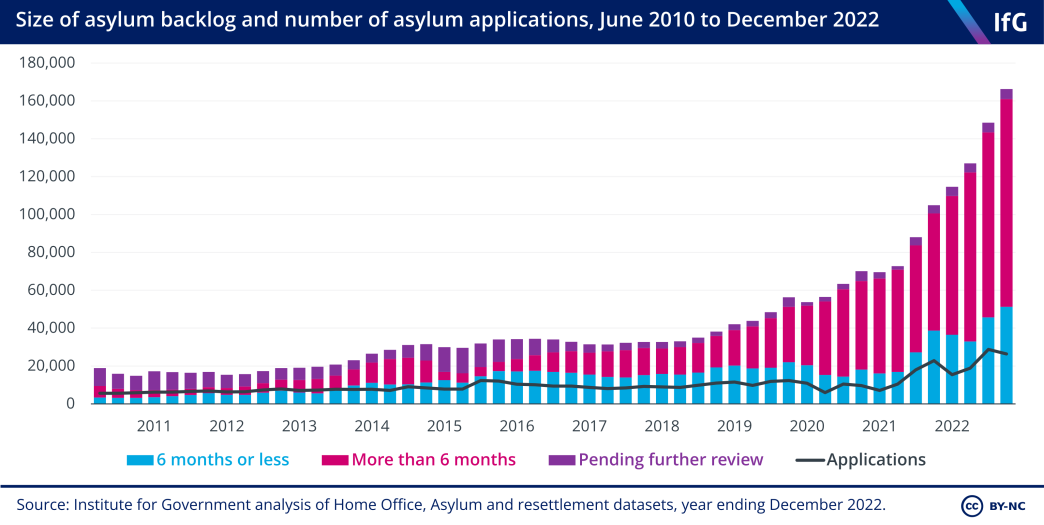
The number of people waiting for an asylum decision has increased by 408% since December 2017. Before this, the backlog had remained relatively stable at around 31,000 from 2014 to 2017. There have been peaks similar to the one seen now in the past: in 2000 the backlog stood at over 100,000, which MPs attributed to a combination of Home Office mismanagement and an increase in applicants due to the conflict in Kosovo. 41 Travis A, ‘Asylum seekers up 55% as backlog grows’, The Guardian, 26 January 2000, https://www.theguardian.com/uk/2000/jan/26/immigration.immigrationandpublicservices
The number of annual asylum applications has increased: it rose 160% between Q4 2017 and Q4 2022 (from 26,764 to 72,027). But in the same period the backlog increased to five times its size. The House of Commons Home Affairs Select Committee (HASC) has concluded that the slow processing of applications has been a bigger driver in increases to the backlog than the increase in the number of applications themselves. 42 House of Commons Home Affairs Committee (HASC), Channel crossings, migration and asylum, First Report of Session 2022–23 (HC 505), 2022, https://committees.parliament.uk/publications/23102/documents/180406/default/, p. 6
Asylum applicants are also waiting longer. Of the cases in the backlog in December 2022 two-thirds, almost 110,000 people, had been waiting over six months, up from 44% of cases in December 2017. Just under a third (31%) have been awaiting a decision for six months or less, while 3% of applications are pending further review.
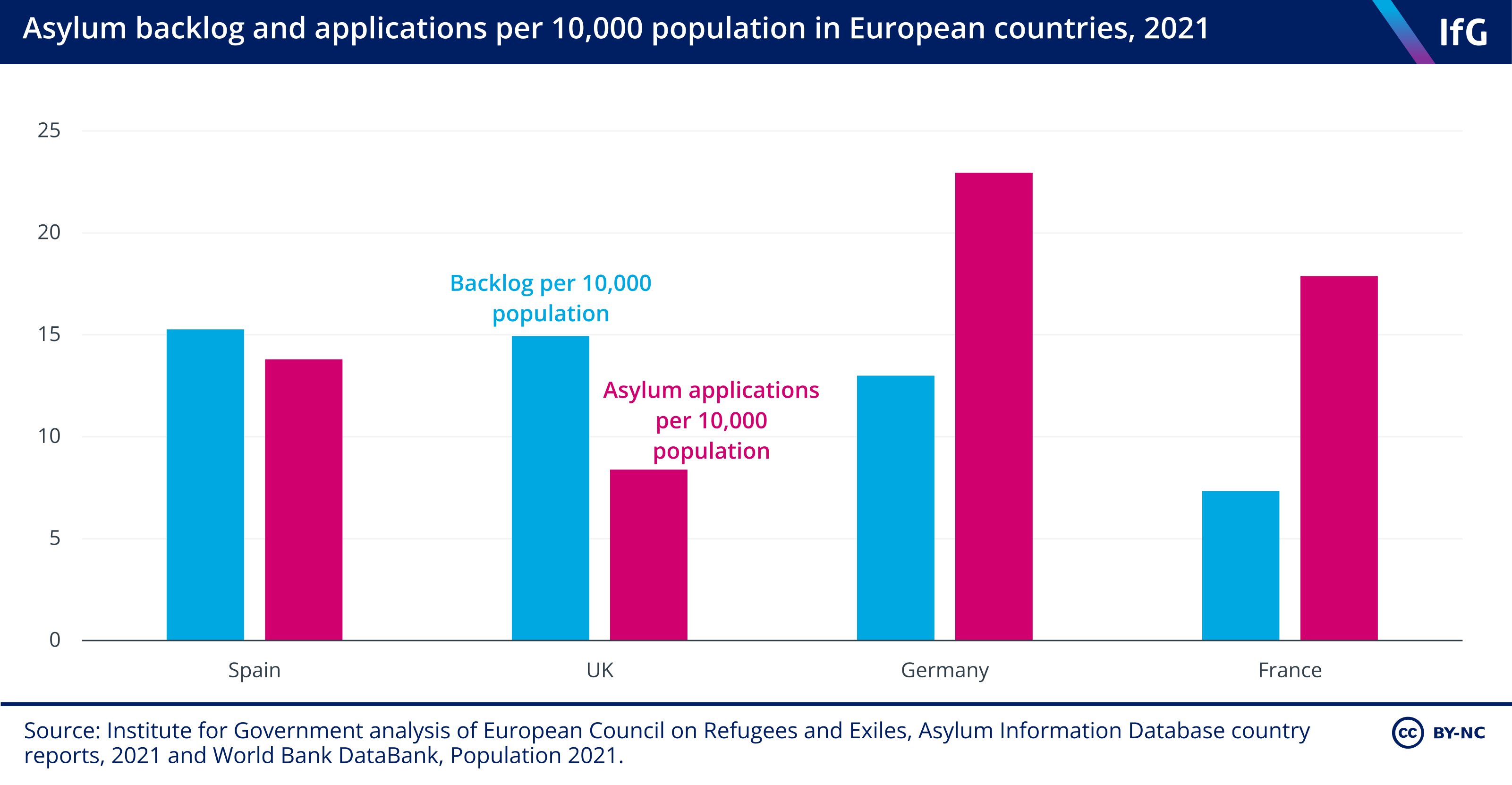
In 2021, the UK had 14.9 cases in the asylum backlog per 10,000 population, more than Germany (13.0) and France (7.3), and just behind Spain (15.3). This is despite it receiving far fewer asylum applications per 10,000 people (8.4) than all three (13.8 for Spain, 17.9 for France and 23.0 for Germany).
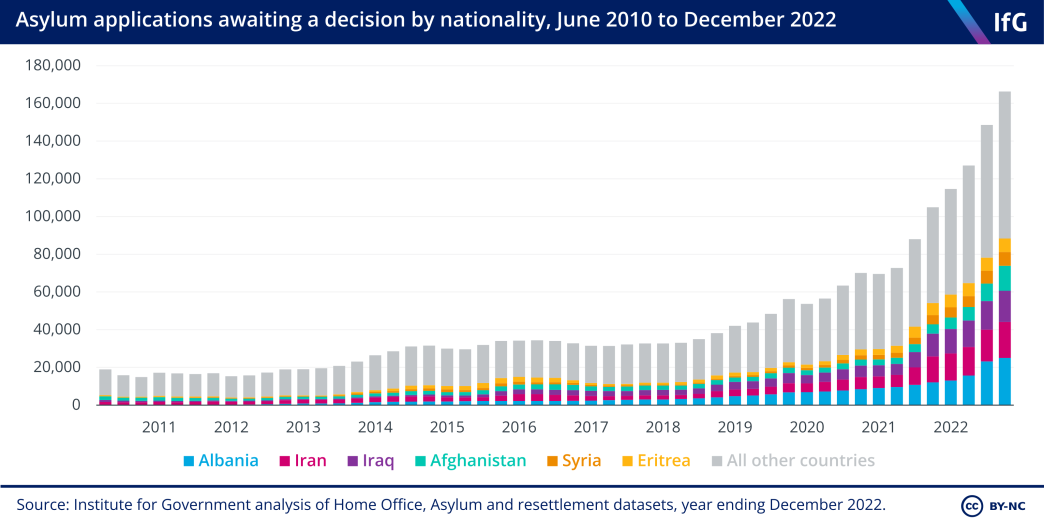
At the end of 2022, the top six countries of nationality in the asylum backlog were: Albania (25,014), Iran (19,112), Iraq (16,551), Afghanistan (13,179), Eritrea (7,382) and Syria (7,068). Together these comprised just over half (53%) of the cases awaiting a decision. Iran, Afghanistan, Eritrea and Syria all have grant rates of over 80% at the initial decision. 49 Home Office, ‘How many people do we grant protection to?’, 23 February 2023, https://www.gov.uk/government/statistics/immigration-system-statistics-year-ending-december-2022/how-many-people-do-we-grant-protection-to
Why is the backlog a problem?
Asylum claimants who received an initial decision in 2020 waited an average of 449 days for that decision, rising to 550 days for unaccompanied asylum-seeking children. 50 Independent Chief Inspector of Borders and Immigration (ICIBI), An inspection of asylum casework (August 2020 – May 2021), The Stationery Office, November 2021, https://www.gov.uk/government/publications/an-inspection-of-asylum-casework-august-2020-may-2021, p. 2 This has a negative impact on those applicants, including on their mental and physical wellbeing. 51 House of Commons Home Affairs Committee (HASC), Channel crossings, migration and asylum, First Report of Session 2022–23 (HC 505), 2022, https://committees.parliament.uk/publications/23102/documents/180406/default/, p. 8
Supporting asylum seekers awaiting a decision is expensive. The government has a statutory responsibility to support applicants and their dependants if they are destitute or likely to become destitute, covering housing and basic subsistence. 52 Immigration and Asylum Act 1999, Section 95 https://www.legislation.gov.uk/ukpga/1999/33/section/95 Speeding up decisions could lead to savings: the Refugee Council estimated in 2021 that the costs of only those who had been waiting for more than six months were £220 million per year. 53 Refugee Council, Living in Limbo: A decade of delays in the UK asylum system, 1 July 2021, https://www.refugeecouncil.org.uk/wp-content/uploads/2021/07/Living-in-Limbo-A-decade-of-delays-in-the-UK-Asylum-system-July-2021.pdf, p. 17 In December 2022 the prime minister stated that the government was paying £5.5m a day to accommodate asylum seekers in hotels. 54 House of Commons, Hansard, ‘Illegal Immigration’, 13 December 2022, col. 886
What is causing the backlog?
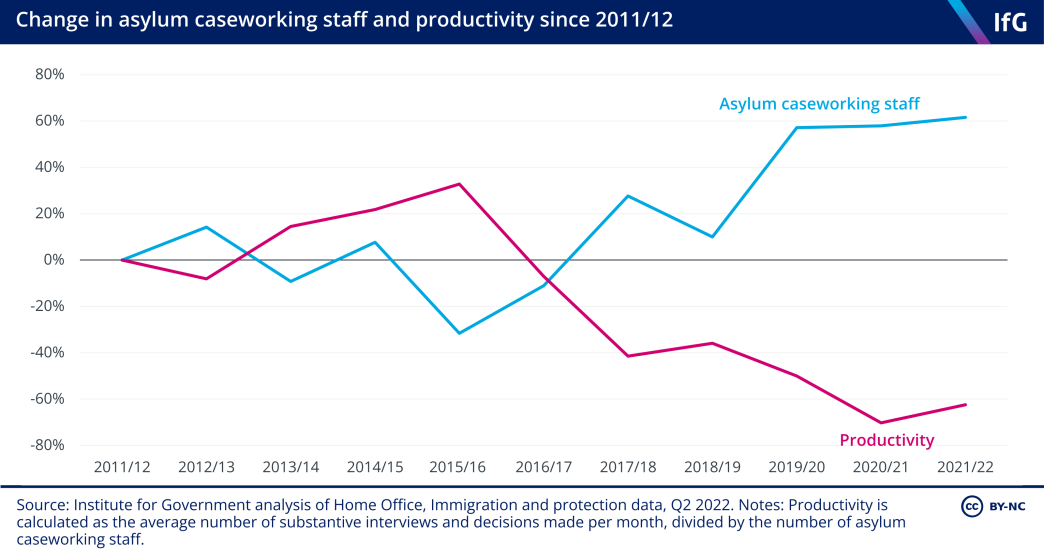
Despite a 62% increase in caseworkers from 2011/12 to 2021/22, decision making rates have decreased by the same amount in this period. And in December 2022, there were 1,237 caseworkers who made an average of four asylum decisions per month per staff member, compared to 380 caseworkers with a productivity rate of 13.7 decisions in 2011/12.
An inspection of asylum casework by the Independent Chief Inspector of Borders and Immigration (ICIBI) in 2021 noted a number of factors contributing to this decline in productivity: 64 Independent Chief Inspector of Borders and Immigration (ICIBI), An inspection of asylum casework (August 2020 – May 2021), The Stationery Office, November 2021, https://www.gov.uk/government/publications/an-inspection-of-asylum-casework-august-2020-may-2021
- a shortage of technical specialist staff to provide guidance and support to asylum decision makers and conduct quality assurance
- inadequate training for asylum interviews
- low morale and high turnover among decision makers, attributed to a pressure to meet targets and a lack of career progression
- the removal in 2019 of an official service standard, to decide 98% of ‘straightforward cases’ within six months.
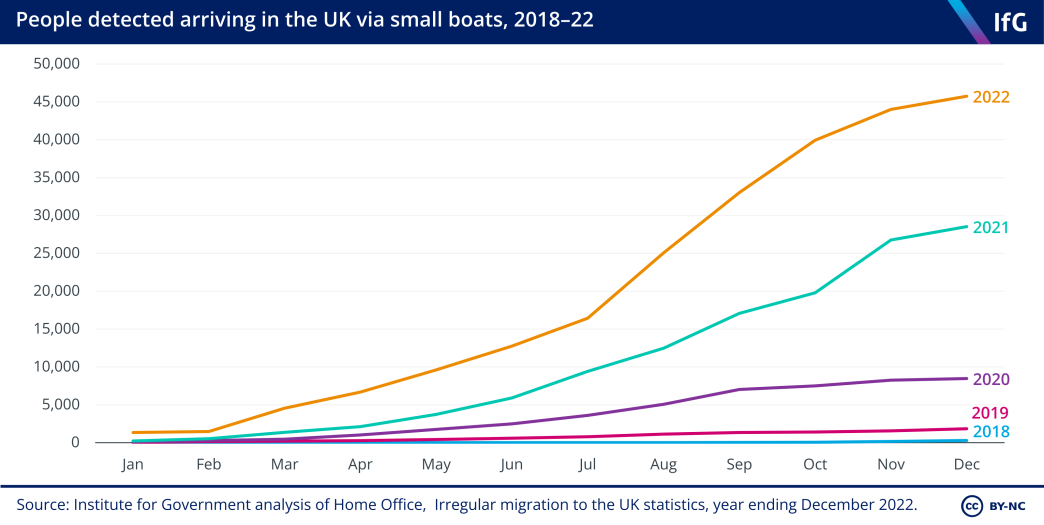
The number of people arriving irregularly in the UK in small boats has increased in recent years. Many of this number seek asylum, including 90% of the 45,755 who arrived in 2022 65 Home Office, ‘How many people do we grant protection to?’, 23 February 2023, https://www.gov.uk/government/statistics/immigration-system-statistics-year-ending-december-2022/how-many-people-do-we-grant-protection-to – Refugee Council analysis found that six in ten are likely to be recognised as refugees. 66 Refugee Council, The Truth About Channel Crossings, January 2023, https://www.refugeecouncil.org.uk/information/resources/the-truth-about-channel-crossings/ Of those who arrived in small boats in 2021, 96% are still awaiting a decision. 67 House of Commons Home Affairs Committee (HASC), Oral evidence: Channel crossings, HC 822, 26 October 2022, https://committees.parliament.uk/oralevidence/11390/pdf/, Q7
The HASC has found that asylum operations have been poorly resourced by successive governments, including before the increases in Channel crossings. 68 House of Commons Home Affairs Committee (HASC), Channel crossings, migration and asylum, First Report of Session 2022–23 (HC 505), 2022, https://committees.parliament.uk/publications/23102/documents/180406/default/, p. 20 But under new immigration rules, some people arriving on small boats are deemed ‘inadmissible’ for asylum if they have a connection to a ‘safe third country’ – and the absence of returns agreements with EU countries means the Home Office risks adding these cases to the asylum backlog when they are unable to return these individuals to another country. 69 Independent Chief Inspector of Borders and Immigration (ICIBI), An inspection of asylum casework (August 2020 – May 2021), The Stationery Office, November 2021, https://www.gov.uk/government/publications/an-inspection-of-asylum-casework-august-2020-may-2021, p. 3
What steps are being considered and tried to clear the backlog?
As part of its drive to clear the backlog of cases from before 28 June 2022, the Home Office has implemented a number of measures to try to clear the backlog. More staff have been hired, taking the number of asylum decision makers to over 1,000. The Home Office also claims to have simplified the interview process, introduced caseworking units specialised by nationality, and reduced staff attrition by 30%. 70 Letter from Home Secretary on asylum backlog and Channel crossings, HASC, 29 January 2023, https://committees.parliament.uk/publications/33804/documents/184602/default/ In February 2023 the department announced it would streamline the process for nationalities with high grant rates.
Other steps have been proposed. At a recent Institute for Government event, former Home Office permanent secretary Philip Rutnam highlighted the 2014 move to downgrade the role of asylum decision maker to executive officer (EO) level from the more senior higher executive officer (HEO) level – suggesting that the EO grade is a relatively junior level for those making ‘life-changing decision[s]’. A 2019 Home Office review found that re-grading the position to HEO level would improve retention and recruitment. 71 Independent Chief Inspector of Borders and Immigration (ICIBI), An inspection of asylum casework (August 2020 – May 2021), The Stationery Office, November 2021, https://www.gov.uk/government/publications/an-inspection-of-asylum-casework-august-2020-may-2021, p. 55 However no action has been taken on this yet.
The UN Refugee Agency recommended in 2021 that the government should invest in resources at the registration and screening stages of the asylum process. It also recommended triaging asylum cases to prioritise ‘manifestly founded and unfounded’ claims – such systems are in place in Canada and Sweden. 72 UNHCR, Guide to Asylum Reform in the United Kingdom, 23 February 2021, https://www.unhcr.org/uk/609123ed4/unhcrs-guide-to-asylum-reform-in-the-united-kingdom, p. 2
- Topic
- Policy making
- Keywords
- Immigration
- Department
- Home Office
- Publisher
- Institute for Government